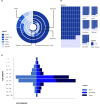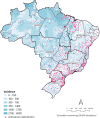Who are the most affected by Bothrops snakebite envenoming in Brazil? A Clinical-epidemiological profile study among the regions of the country
- PMID: 37856557
- PMCID: PMC10617728
- DOI: 10.1371/journal.pntd.0011708
Who are the most affected by Bothrops snakebite envenoming in Brazil? A Clinical-epidemiological profile study among the regions of the country
Abstract
Snakebite envenoming represents an important Neglected Tropical Disease (NTD) that mainly affects tropical and subtropical developing countries according to the World Health Organization (WHO). As a priority issue in the tropics, it is estimated that accidental encounter between snakes and humans is the leading cause of morbidity and mortality among all NTDs in the world. In Brazil, an extremely diverse country with continental dimensions, snakebite envenoming is the second leading cause of reported human envenoming. Treating the disease has been an unprecedented challenge for Brazilian Health Systems for decades. Despite access to Antivenom therapy and distributing it free of charge across the country, Brazil faces numerous issues regarding the notification process and accurate treatment targeting for at-risk populations. Thus, this study aimed to identify the temporal epidemiological dynamics of accidents caused by Bothrops snakes in Brazil, the country's major group of venomous snakes, based on secondary information from the online database provided by The Brazilian Notifiable Diseases Information System (SINAN). For this purpose, reported Bothrops snakebites between 2012 and 2021 were counted, then the data were analyzed. We looked at the frequency, occurrence, mortality rates, case fatality rate (CFR), age and gender distribution, and the time lapse between the incident and the initiation of Antivenom therapy. The data were also organized considering regional variations of the country. Throughout the studied period, a total of 202,604 cases of envenoming caused by Bothrops spp. were notified, resulting in 766 fatalities. These accidents were found to occur in variable proportions across different regions in Brazil, with notable concentrations observed in the North, Northeast, and Southeast regions. The epidemiological profile of patients varied greatly between the regions, revealing that snake envenoming is much more a social, economic, and ecological problem than a medical one. In conclusion, our study provides an overview of the clinical and epidemiological profile of envenoming by Bothrops snakes in Brazil. Notably, this is the first study to present such information in a country as vast and diverse as Brazil, encompassing a comparative analysis of its regions using SINAN data, that proves to be a very useful national tool to improve the control and management of envenoming.
Copyright: © 2023 da Silva et al. This is an open access article distributed under the terms of the Creative Commons Attribution License, which permits unrestricted use, distribution, and reproduction in any medium, provided the original author and source are credited.
Conflict of interest statement
The authors have declared that no competing interests exist.
Figures





References
Publication types
MeSH terms
Substances
LinkOut - more resources
Full Text Sources
Research Materials
Miscellaneous

